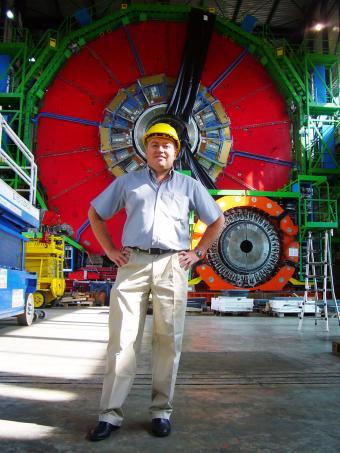PROVIDENCE, R.I. [Brown University] — Greg Landsberg, professor of physics at Brown University, is entering the administrative hierarchy at the world’s grandest and most closely followed scientific experiment.
Landsberg has been appointed physics coordinator for the Compact Muon Solenoid, a detector at the Large Hadron Collider, the preeminent particle collider that is searching for clues to explain the state of the universe less than a millionth of a second after the Big Bang.
As physics coordinator, Landsberg defines the goals and types of experiments that researchers will undertake at the CMS as the detector hunts for particles theorized to exist and possibly new ones as well. He is taking a two-year sabbatical to work full time at the European Organization for Nuclear Research (CERN), which is in charge of the CMS and other detectors at the Large Hadron Collider, located outside Geneva.
“I think these will be two of the most exciting years,” Landsberg said. “These really are the years to make it (discoveries) or lose it.”
The physics coordinator is considered one of most important positions in the CMS collaboration, akin to a cabinet-level post in a U.S. presidential administration. The detector’s new spokesperson, Joe Incandela, asked Landsberg to join the team in June. The CMS management board approved the selection, and the collaboration’s 2,500 voting members ratified the choice later that month. Landsberg will move to CERN in late December. He and his wife will live across the border in Challex, France.
“Greg’s appointment as the CMS physics coordinator positions him at the hub of the detector’s activities,” said James Valles Jr., chair of the Department of Physics. “It is fantastic that one of our professors will provide leadership over the research of thousands of physicists, especially during this early phase when substantial new discoveries about our universe are highly anticipated.”
Arguably the biggest pursuit by CMS and its competitor detector, called ATLAS, is to establish the existence of the Higgs boson, which some scientists believe gives matter mass. Landsberg expects that during his time at CERN, “we either find the Standard Model Higgs or exclude it completely; obviously we hope for the former.”
Besides the hunt for the Higgs, Landsberg hopes the detector will find super symmetry, discover new forces, and even reveal extra spatial dimensions.
“We don’t know where these discoveries will come from,” he said.
He said a day at the office would involve reading through hundreds of emails from fellow physicists around the world, attending meetings and conferences and reviewing potential manuscript submissions to scientific journals as well as collaborating with the ATLAS team on data.
“There’s no such thing as a typical day,” he added.
Landsberg grew up in Moscow and has lived in the United States for nearly 20 years. He joined the Brown faculty in 1998 following a stint as a postdoctoral researcher at the Fermi National Accelerator Laboratory in Illinois. At Brown, he does research in elementary particle physics, specifically experimental investigation of the fundamental particles and fields at the energy frontier accelerators. His main research activity is the search for new physics phenomena, including extra dimensions in space.

